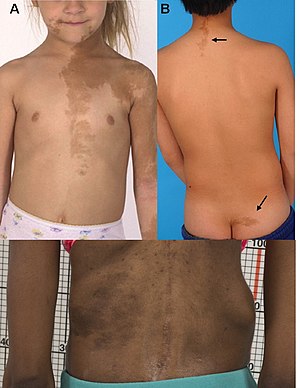Albright syndrome
| McCune-Albright syndrome | |
|---|---|
 |
|
| Café-au-lait skin pigmentation. A) A typical lesion on the face, chest, and arm of a 5-year-old girl with McCune-Albright syndrome which demonstrates jagged "coast of Maine" borders, and the tendency for the lesions to both respect the midline and follow the developmental lines of Blaschko. B) Typical lesions that are often found on the nape of the neck and crease of the buttocks are shown (arrows). |
|
| Classification and external resources | |
| Specialty | medical genetics |
| ICD-10 | Q78.1 |
| ICD-9-CM | 756.54 |
| OMIM | 174800 |
| DiseasesDB | 7880 |
| MedlinePlus | 001217 |
| eMedicine | ped/1386 |
| Patient UK | McCune–Albright syndrome |
| MeSH | D005359 |
| Orphanet | 562 |
McCune–Albright syndrome, also known as Albright syndrome, is a complex genetic disorder affecting the bone, skin, and endocrine systems.
It was first described in 1937 by Donovan James McCune and Fuller Albright.
McCune–Albright syndrome is suspected when one or more of the following features are present:
Within the syndrome there are bone fractures and deformity of the legs, arms and skull, different pigment patches on the skin, and early puberty with increased rate of growth.
Approximately 20-30% of fibrous dysplasias are polyostotic, which means fibrous dysplasia and sclerotic bone are present in multiple sites; two thirds of patients are polyostotic before the age of ten. The disease frequently involves the skull and facial bones, pelvis, spine and shoulder girdle. The sites of involvement are the femur (91%), tibia (81%), pelvis (78%), ribs, skull and facial bones (50%), upper extremities, lumbar spine, clavicle, and cervical spine, in decreasing order of frequency. The craniofacial pattern of the disease occurs in 50% of patients with the polyostotic form of fibrous dysplasia.
Increased production of hormones by glands regulated by the G protein system is due to a mutation in the gene causing continuous activation of stimulatory G protein. This results in the so-called "autonomous production" of hormones, including thyroid hormone, cortisol, estrogen and growth hormone. Therefore, hyperthyroidism, Cushing syndrome, precocious puberty in women with premature thelarche (breast growth), premature menarche (beginning of menstrual function), increased speed of growth and growth hormone excess can ensue. Increased serum estrogen concentrations correlate with large ovarian cysts. Ovarian cysts appear and disappear with changing estrogen concentrations, causing menstrual bleeding when estrogen decreases.
...
Wikipedia
